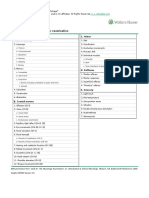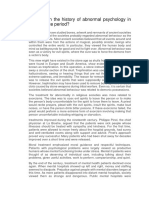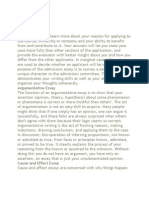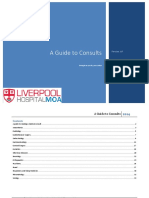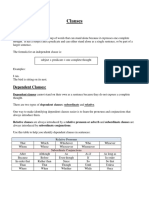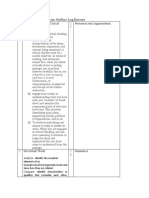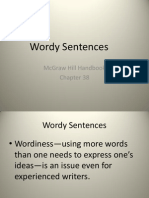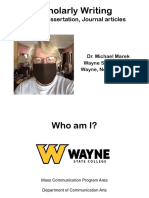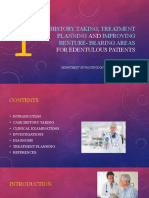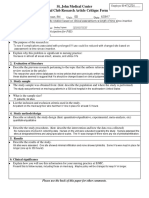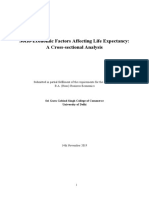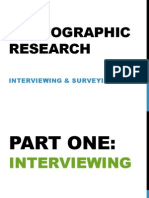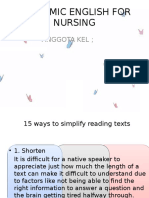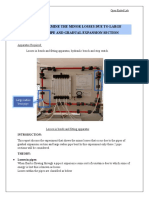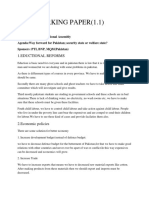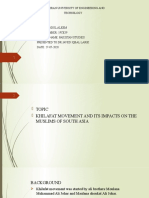Paraphrasing
Paraphrasing
Uploaded by
Sachin ShindeCopyright:
Available Formats
Paraphrasing
Paraphrasing
Uploaded by
Sachin ShindeCopyright
Available Formats
Share this document
Did you find this document useful?
Is this content inappropriate?
Copyright:
Available Formats
Paraphrasing
Paraphrasing
Uploaded by
Sachin ShindeCopyright:
Available Formats
Paraphrasing
The words ‘paraphrasing’ and ‘summarising’ are sometimes used interchangeably, but usually they
are used to mean two different techniques. If you’re not sure if you are required to summarise or
paraphrase, check with your tutor.
A paraphrase is rewriting a piece of text in your own words, while retaining the meaning. It is usually
similar in length to the original text.
A summary, in contrast, is a description of the main ideas of a text, and so it is shorter than the
original text. A journal article might be summarised in a single paragraph, for example, or a whole
book summarised in a few paragraphs. To summarise something – like a TV show or an article – is to
condense it down to the ‘bare bones’.
Both paraphrasing and summarising are important techniques in academic writing.
You’ll use paraphrasing and summarising both when you take notes during your research and when
you incorporate evidence from sources into your own work.
Paraphrase vs Summary
Paraphrase Summary
Should be about the same length as the original text Can be very short
More detailed than summary and can include supporting Communicates only the main ideas, leaving out supporting
ideas and examples ideas and examples
Uses different words to the original text Uses different words to the original text
Paraphrasing is both a technique for using evidence and an academic skill in itself. Sometimes
paraphrasing tasks are set for assessment to see how you are going in developing your skill.
Steps in the paraphrase process
1. First, make sure you understand the source itself. Check the definitions of any keywords if you are
unsure.
2. Next, put the reading aside and make some notes from memory.
3. Then compare your notes with the reading to make sure you have included all the key information.
Redraft your paraphrase if necessary.
4. Place quotation marks around any unique phrases you have borrowed directly from the source.
Note that it is OK not to change technical words, as there often will not be appropriate synonyms
for these.
5. Make sure to note down the full details of the source so you can properly cite the material.
Study Smart Autumn 2024 Page 1 of 6
Paraphrasing westernsydney.edu.au/studysmart
Examples of some paraphrasing techniques
→ Changing positive statements to negative statements and vice versa
→ Changing the words and word order
→ Leaving out unnecessary words and information
→ Changing the sentence structure
→ Preserving technical terms that don’t have appropriate synonyms
Note that paraphrasing is NOT just changing the words around or substituting one or two words for
synonyms.
Also, you cannot just look up each word individually in a dictionary or thesaurus and replace it with a
similar word. You need to choose appropriate vocabulary and integrate your changes across the
sentence or paragraph. Sometimes it might be tempting to use an online translation tool to produce a
new version of a sentence or paragraph, but the result will usually not make sense.
The process of paraphrasing: an example
Sample text from Lewis & Foley (2014, p. 61):
The challenge for you as a student nurse is to move beyond mastering the skills of data collection
to develop your confidence in analysing and interpreting findings, identifying and clustering
abnormal data and determining nursing priorities. Although beginning nurses lack the depth of
knowledge and expertise that experienced nurses have, they can still learn to improve their clinical
judgement skills. Etheridge (2007) found that new nurse graduates learned to "think like a nurse"
and develop confidence in making clinical judgements through multiple clinical experiences with a
wide variety of patients, support from educators and experienced nurses, and sharing experiences
with their peers. Making the most of clinical placements by seeking opportunities to develop these
skills is essential in the transition from student nurse to beginning practitioner.
Following the paraphrasing process
1. Check personal understanding. Are there any words you don’t understand? Look them up.
2. Put the text aside and make some notes from memory. My notes, for example, might read:
→ student nurse data -> analysis
→ priorities
→ lack of knowledge and expertise
→ learning to think like a nurse
→ develop confidence
→ var. pts
→ clinical placement opportunities on placement
3. Compare notes with the text. A lot of key information is missing, so I need to go through the text
carefully and note the important parts, in particular the direct quotes.
4. Redraft paraphrase.
Let’s do this redrafting one sentence at a time:
Study Smart Autumn 2024 Page 2 of 6
Paraphrasing westernsydney.edu.au/studysmart
Sentence 1 from source
The challenge for you as a student nurse is to move beyond mastering the skills of data collection to develop your
confidence in analysing and interpreting findings, identifying and clustering abnormal data and determining
nursing priorities.
First identify the technical words and language features:
→ nurse (there is no word that means exactly the same thing as nurse)
→ data collection
→ This text uses the second person to appeal to the reader on a personal level. Usually we don’t use
‘I’ or ‘you’ in academic writing, so we need to change this to the third person.
What is the key idea of this sentence?
Student nurses need to progress from collecting data to being confident in analysing data to
find abnormalities and prioritise tasks.
Assess: This is both the key idea and a pretty good paraphrase. We’ll keep it.
Changes made:
→ ‘move beyond’ changed to ‘progress’
→ ‘data collection’ changed to ‘collecting data’
→ ‘develop your confidence’ to ‘being confident’
→ Second person (you) changed to third (student nurses)
→ Singular ‘a student nurse’ changed to plural ‘student nurses’
→ Structural change: The second part of the sentence was condensed into analysing data, finding
abnormalities, and prioritising tasks.
Sentence 2 from source
Although beginning nurses lack the depth of knowledge and expertise that experienced nurses have, they can still
learn to improve their clinical judgement skills.
Technical words:
→ nurse
→ clinical judgement
What is the key idea of this sentence?
New nurses don’t have much knowledge or experience but they can learn to improve.
Assess: Contractions are informal, so expand ‘don’t’ to ‘do not’. The sentence doesn’t specify
what it is that nurses can learn to improve, so we should add more information.
New nurses do not have much knowledge or experience, but they can still develop their clinical
judgement.
Study Smart Autumn 2024 Page 3 of 6
Paraphrasing westernsydney.edu.au/studysmart
Changes made:
→ ‘beginning nurses’ to ‘new nurses’
→ ‘lack the depth of knowledge and expertise that experienced nurses have’ rewritten as ‘do not
have much knowledge or experience’
→ ‘although’ replaced with ‘but’ and moved to second clause
→ ‘learn to improve’ changed to ‘develop’
→ ‘skills’ omitted (but sense retained)
Sentence 3 from source
Etheridge (2007) found that new nurse graduates learned to "think like a nurse" and develop confidence in
making clinical judgements through multiple clinical experiences with a wide variety of patients, support from
educators and experienced nurses, and sharing experiences with their peers.
Technical words:
→ nurse
→ clinical judgement
→ patients
Note that this sentence contains a citation that you need to incorporate into your paraphrase.
What is the key idea of this sentence?
Etheridge learned that new nurses could ‘think like a nurse’ and enhance their confidence by gaining experience
with patients, being supported by others, and discussing things that happened with their fellow nurses.
Assess: This is a little informal. We need to add the year and make it a complete secondary
citation, and change words such as ‘things that happened’. We can keep the quotation ‘think
like a nurse’ as long as we retain the quotation marks.
According to Etheridge (2007, as cited in Lewis & Foley, 2014, p. 61), novice nurses can “think like a nurse” and
gain confidence if they have experience with different patients, help from colleagues, and discuss experiences
with their fellow nurses.
Changes made:
→ Added ‘according to Etheridge’ and formatted this as a secondary citation
→ ‘new nurses’ to ‘novice nurses’
→ ‘develop confidence’ to ‘gain confidence’
→ omitted ‘in making clinical judgements through multiple clinical experience’
→ added conditional ‘if’ clause
→ ‘a wide variety of patients’ replaced with ‘different patients’
→ ‘support from educators and experienced nurses’ changed to ‘help from colleagues’
→ ‘sharing experiences with their peers’ replaced with ‘discuss experiences with their fellow nurses’
Study Smart Autumn 2024 Page 4 of 6
Paraphrasing westernsydney.edu.au/studysmart
Sentence 4 from source
Making the most of clinical placements by seeking opportunities to develop these skills is essential in the
transition from student nurse to beginning practitioner.
Technical words:
→ clinical
→ nurse
What is the key idea of this sentence?
It’s important to seek opportunities to improve skills during placement to transition from student nurse to novice
health professional.
Assess: This is a good summary of the key idea but too many words are similar to the original
text. We can also restructure the sentence so the student nurse is at the beginning.
Student nurses should look to improve their clinical skills during placement to assist in the passage to starting
work.
Changes made:
→ The sentence structure: ‘making the most of clinical placements…’ does not have a direct subject,
only an implied subject. We have rewritten this as an active construction with ‘student nurses’ as
the subject.
→ ‘Making the most of clinical placements by seeking opportunities to develop these skills’ changed
to ‘look to improve their clinical skills during placement’.
→ ‘the transition from student nurse to beginning practitioner’ changed to ‘the passage to starting
work’.
→ the concept that ‘making the most’ is ‘essential’ has been changed to improving skills being able
‘to assist’ in the transition to work. This is an alteration in meaning but only a small one; the key
idea of the sentence has still been preserved.
Now let’s compare the original text and our paraphrase:
Original text Paraphrase
The challenge for you as a student nurse is to move beyond Student nurses need to progress from collecting data to
mastering the skills of data collection to develop your being confident in analysing data to find abnormalities and
confidence in analysing and interpreting findings, prioritise tasks. New nurses do not have much knowledge or
identifying and clustering abnormal data and determining experience, but they can still develop their clinical
nursing priorities. Although beginning nurses lack the depth judgement. According to Etheridge (2007, as cited in Lewis
of knowledge and expertise that experienced nurses have, & Foley, 2014, p. 61), novice nurses can “think like a nurse”
they can still learn to improve their clinical judgement skills. and gain confidence if they have experience with different
Etheridge (2007) found that new nurse graduates learned patients, help from colleagues, and discuss experiences with
to “think like a nurse” and develop confidence in making their fellow nurses. Student nurses should look to improve
clinical judgements through multiple clinical experiences their clinical skills during placement to assist in the passage
with a wide variety of patients, support from educators and to starting work.
experienced nurses, and sharing experiences with their
peers. Making the most of clinical placements by seeking
opportunities to develop these skills is essential in the
transition from student nurse to beginning practitioner.
Study Smart Autumn 2024 Page 5 of 6
Paraphrasing westernsydney.edu.au/studysmart
Assess:
→ Have technical words been preserved?
→ Are the key ideas of the original text communicated in the paraphrase?
→ Is the paraphrase too close to the original or using too many of the same words?
→ Have direct quotes been appropriately referenced?
→ Is the paraphrase a cohesive and clear piece of writing?
→ Would you make any changes?
Integrating paraphrases into your writing
Now that we’ve made a paraphrase of the source, how do we use it?
Imagine that you’re writing an essay. The topic is:
‘Describe some of the challenges faced by student nurses, and ways that these challenges can be overcome.’
You have decided to discuss the essay topic in two parts: clinical challenges and personal challenges.
This is an example of how we can use our paraphrase of the paragraph in Lewis & Foley (2014) to
discuss clinical challenges:
Student nurses face multiple challenges in the clinical environment, but they are not impossible to overcome.
Lewis and Foley (2014) note that new nurses do not have much knowledge or experience, but they can still
develop their clinical judgement. Improvement can come from many avenues. According to Etheridge (2007, as
cited in Lewis & Foley, 2014, p. 61), novice nurses can “think like a nurse” and gain confidence if they have
experience with different patients, help from colleagues, and discuss experiences with their fellow nurses.
Here we have integrated our paraphrases of sentences 2 and 3 into a coherent paragraph, with a
topic sentence and context for the evidence from sources.
More information
→ Western Sydney University Library Referencing and Citation guide
→ Royal Literary Fund: Direct quotation, paraphrasing and referencing
→ The Writing Center at UNC-Chapel Hill: Quotations
References
Lewis, P., & Foley, D. (2014). Health assessment in nursing. Philadelphia, PA: Wolters Kluwer /
Lippincott Williams & Wilkins.
Study Smart Autumn 2024 Page 6 of 6
Paraphrasing westernsydney.edu.au/studysmart
You might also like
- Neurologic Examination - UpToDateDocument1 pageNeurologic Examination - UpToDateamandaNo ratings yet
- Pramod Written Assignment 2 hlth103Document19 pagesPramod Written Assignment 2 hlth103api-494297002100% (1)
- The Complete Plain WordsDocument1 pageThe Complete Plain Wordsyasir sulaimanNo ratings yet
- Write Down The History of Abnormal Psychology in Renaissance PeriodDocument12 pagesWrite Down The History of Abnormal Psychology in Renaissance PeriodKashish GautamNo ratings yet
- Dealing With ChangeDocument4 pagesDealing With ChangegabriellejonesNo ratings yet
- CRAAP Test Worksheet - Water PollutionDocument2 pagesCRAAP Test Worksheet - Water PollutioncheyNo ratings yet
- Models of Organisation BehaviourDocument3 pagesModels of Organisation BehaviourManish SinghNo ratings yet
- A1 WorkbookDocument120 pagesA1 WorkbookJenny Edith Espinoza VeraNo ratings yet
- Aspects of Academic WritingDocument4 pagesAspects of Academic WritingWenn Joyrenz ManeclangNo ratings yet
- How To Cite Examples in Ielts Task TwoDocument1 pageHow To Cite Examples in Ielts Task TwoJoshua WiltsonNo ratings yet
- Hedging LanguageDocument2 pagesHedging LanguageSafat Al Mamun RonoNo ratings yet
- Admission Essay: Types of EssaysDocument14 pagesAdmission Essay: Types of EssaysJessa LuzonNo ratings yet
- Direct Speech WorksheetDocument5 pagesDirect Speech WorksheetPriyeshNo ratings yet
- Suggestions For Process EssayDocument4 pagesSuggestions For Process EssayjmaurpNo ratings yet
- Homophones 1 Homophones 2Document1 pageHomophones 1 Homophones 2Lucia MeloNo ratings yet
- Sample Informed Consent Form: Instructions To The Student ResearcherDocument1 pageSample Informed Consent Form: Instructions To The Student ResearcherSylark100% (1)
- Identifying Strengths and WeaknessesDocument7 pagesIdentifying Strengths and WeaknessesKevin EspinosaNo ratings yet
- Activities of Daily Living in Patients With Dementia - Clinical Relevance, Methods of Assessment and Effects of TreatmentDocument23 pagesActivities of Daily Living in Patients With Dementia - Clinical Relevance, Methods of Assessment and Effects of TreatmentMelisa CastilloNo ratings yet
- A Guide To ConsultsDocument36 pagesA Guide To ConsultsspamvarunNo ratings yet
- A Systematic Review of The Effects of Soft Splinting On Upper Limb Function in People With Cerebral PalsyDocument22 pagesA Systematic Review of The Effects of Soft Splinting On Upper Limb Function in People With Cerebral PalsyFina YusfinaNo ratings yet
- The Expert Patient: A New Approach To Chronic Disease Management For The 21st CenturyDocument35 pagesThe Expert Patient: A New Approach To Chronic Disease Management For The 21st CenturyPatients Know BestNo ratings yet
- Nursing 350 Reflection PaperDocument7 pagesNursing 350 Reflection Paperapi-2518349340% (1)
- Grammar Booklet 2Document10 pagesGrammar Booklet 2api-317227717No ratings yet
- General Psychology SlideDocument98 pagesGeneral Psychology SlideKidane HailuNo ratings yet
- Subjectivity, Intersubjectivity and Epistemic ComplementationDocument18 pagesSubjectivity, Intersubjectivity and Epistemic ComplementationSandra MartínNo ratings yet
- Reflective Practice-The FrameworksDocument18 pagesReflective Practice-The FrameworksayazlaghariNo ratings yet
- Persuasive Presentation RubricsDocument6 pagesPersuasive Presentation RubricsLuCiFeR GamingNo ratings yet
- The Science of Wellbeing and Positive PsychologyDocument14 pagesThe Science of Wellbeing and Positive PsychologystefanNo ratings yet
- Phil 152 Assg 1Document6 pagesPhil 152 Assg 1kedisha samuels100% (1)
- How To Learn A Foreign Language Effectively: Sample Essay AnalysisDocument1 pageHow To Learn A Foreign Language Effectively: Sample Essay AnalysisShimulAhmedNo ratings yet
- Wordy SentencesDocument30 pagesWordy SentencesLeo KingNo ratings yet
- How To Write A Psychology Dissertation Literature ReviewDocument6 pagesHow To Write A Psychology Dissertation Literature Reviewgw2cgcd9No ratings yet
- LCH1056 How To Do An Oral PresentationDocument20 pagesLCH1056 How To Do An Oral PresentationDorcas MokNo ratings yet
- Scholarly Writing: Thesis, Dissertation, Journal ArticlesDocument42 pagesScholarly Writing: Thesis, Dissertation, Journal ArticlesDaniel TanNo ratings yet
- The Latest Updates On The Prevention and Treatment of Alzheimer's Disease A Special Interview With Dr. Dale BredesenDocument26 pagesThe Latest Updates On The Prevention and Treatment of Alzheimer's Disease A Special Interview With Dr. Dale Bredesensilvana aquinoNo ratings yet
- Using ParallelismDocument9 pagesUsing ParallelismHydzTallocoyNo ratings yet
- English Presentation Skill Opening, SignalingDocument22 pagesEnglish Presentation Skill Opening, Signalingsrm class100% (1)
- 6 Simple Steps For Writing A Research Paper PDFDocument2 pages6 Simple Steps For Writing A Research Paper PDFPrabhat SinghNo ratings yet
- What Is An Expository Essay?Document3 pagesWhat Is An Expository Essay?mmendizabal100% (1)
- History Taking, Treatment Planning 1Document117 pagesHistory Taking, Treatment Planning 1bhamaNo ratings yet
- Topic Proposal PaperDocument4 pagesTopic Proposal Paperapi-405275958No ratings yet
- Chasee Brown Journal Club CritiqueDocument1 pageChasee Brown Journal Club Critiqueapi-357707616No ratings yet
- SOAP BasicsDocument26 pagesSOAP BasicsErin SantosNo ratings yet
- Group - 1 - Socio Economic Factors Affecting Life Expectancy - FINAL (2) - Converted - by - AbcdpdfDocument22 pagesGroup - 1 - Socio Economic Factors Affecting Life Expectancy - FINAL (2) - Converted - by - AbcdpdfAniket GawandeNo ratings yet
- Ethnography 1 (Project Two)Document18 pagesEthnography 1 (Project Two)Lisa Ann Curtin100% (1)
- Writing A Lab Report: TitleDocument11 pagesWriting A Lab Report: TitleGus Ostow100% (1)
- MI Change PlanDocument3 pagesMI Change Planeclatant100% (1)
- Brief APA Publication Manual GuidelinesDocument15 pagesBrief APA Publication Manual Guidelinesmasoud1716No ratings yet
- Biological Explanations of SchizophreniaDocument31 pagesBiological Explanations of SchizophreniacandiceNo ratings yet
- Apa Reference Page TutorialDocument12 pagesApa Reference Page Tutorialapi-277513618No ratings yet
- Hedging Language Text ComparisonDocument2 pagesHedging Language Text ComparisonTrần Quỳnh TrangNo ratings yet
- DocumentDocument4 pagesDocument명수김No ratings yet
- Academic English For NursingDocument22 pagesAcademic English For Nursingtika_8762671530% (1)
- What Is Plagiarism?Document6 pagesWhat Is Plagiarism?Shreyans DugarNo ratings yet
- Understanding Transgender Issues: Suicide RiskDocument14 pagesUnderstanding Transgender Issues: Suicide RiskPeter Sprigg100% (1)
- Top 10 Mental Health Interview Questions and AnswersDocument16 pagesTop 10 Mental Health Interview Questions and Answersmassijonh100% (1)
- How To Create A Research IdeaDocument43 pagesHow To Create A Research IdeaHala EnabaNo ratings yet
- Paraphrasing and SummarizingDocument25 pagesParaphrasing and SummarizingFrida BrNo ratings yet
- Integrating Quotes Paraphrases Research PapersDocument7 pagesIntegrating Quotes Paraphrases Research Papersgvzexnzh100% (1)
- Research Paper Terms and DefinitionsDocument5 pagesResearch Paper Terms and Definitionsaflskdwol100% (1)
- How Do We Write Thesis StatementDocument5 pagesHow Do We Write Thesis Statementjuliechampagnemanchester100% (2)
- Cross Slope and Superelevation: GeneralDocument18 pagesCross Slope and Superelevation: GeneralABDUL ALEEMNo ratings yet
- Lecture 08-1 Yield of WellsDocument36 pagesLecture 08-1 Yield of WellsABDUL ALEEMNo ratings yet
- Experiment No 8Document2 pagesExperiment No 8ABDUL ALEEMNo ratings yet
- To Determine The Minor Losses Due To LargeDocument8 pagesTo Determine The Minor Losses Due To LargeABDUL ALEEMNo ratings yet
- An Asymmetrical Fold Is One in Which The Axial Plane Is InclinedDocument2 pagesAn Asymmetrical Fold Is One in Which The Axial Plane Is InclinedABDUL ALEEMNo ratings yet
- Working Paper (1.1) : 1.eductional ReformsDocument3 pagesWorking Paper (1.1) : 1.eductional ReformsABDUL ALEEMNo ratings yet
- Experiment No 7Document2 pagesExperiment No 7ABDUL ALEEMNo ratings yet
- Cloth, Varnier Caliper With The Accuracy of 0.1mm To Measure The Length and Dia of Core Samples. of Regular SizesDocument2 pagesCloth, Varnier Caliper With The Accuracy of 0.1mm To Measure The Length and Dia of Core Samples. of Regular SizesABDUL ALEEMNo ratings yet
- P24LabExam Answers PDFDocument3 pagesP24LabExam Answers PDFABDUL ALEEMNo ratings yet
- Mehran University of Engineering and Techn0LogyDocument6 pagesMehran University of Engineering and Techn0LogyABDUL ALEEMNo ratings yet
- AlbertEinstein PDFDocument3 pagesAlbertEinstein PDFABDUL ALEEMNo ratings yet
- Quiz 4 - Even & Online Hamnah Lateef 221-437046Document4 pagesQuiz 4 - Even & Online Hamnah Lateef 221-437046hamnah lateefNo ratings yet
- Scheme of Work Year 3 (SK)Document24 pagesScheme of Work Year 3 (SK)Nurul HudainiNo ratings yet
- Teaching Students With ADD ADHDDocument4 pagesTeaching Students With ADD ADHDKalia ChNo ratings yet
- BetelDocument4 pagesBetelabrehamcheru1No ratings yet
- Storyfun Come Alive Bringing Stories To Live Through Creativ PDFDocument29 pagesStoryfun Come Alive Bringing Stories To Live Through Creativ PDFMaura Colaizzo100% (2)
- OpexDocument16 pagesOpexMAFEROSONo ratings yet
- Caitlin Bossert Resume 2024Document1 pageCaitlin Bossert Resume 2024api-375319204No ratings yet
- 21ST Century Literature Q2 Week 7Document3 pages21ST Century Literature Q2 Week 7liwanclarence24No ratings yet
- Admissions, Attrition, Retention, Excel-Data Matrix and ReportDocument18 pagesAdmissions, Attrition, Retention, Excel-Data Matrix and ReportWendel AbejoNo ratings yet
- Ips Lesson PlanDocument6 pagesIps Lesson Planapi-531811515No ratings yet
- Comprehensive Examination in Advanced Educational PsychologyDocument5 pagesComprehensive Examination in Advanced Educational PsychologyKaela Lor100% (2)
- 1pengembangan TimDocument70 pages1pengembangan TimadminNo ratings yet
- Large Graph Models: A Perspective: Ziwei Zhang, Haoyang Li, Zeyang Zhang, Yijian Qin, Xin Wang, Wenwu ZhuDocument23 pagesLarge Graph Models: A Perspective: Ziwei Zhang, Haoyang Li, Zeyang Zhang, Yijian Qin, Xin Wang, Wenwu ZhuChu ChítNo ratings yet
- Pause Giant AI Experiments: An Open LetterDocument3 pagesPause Giant AI Experiments: An Open LetterFotografía DigitalNo ratings yet
- Case Study Mental RetardationDocument8 pagesCase Study Mental RetardationElirene IrenNo ratings yet
- 2016 03 31 Quarter 4 Grade 1 Ilokano Teacher's GuideDocument217 pages2016 03 31 Quarter 4 Grade 1 Ilokano Teacher's GuideiKids SentenceBuilderNo ratings yet
- Analysis and Prediction of Football Statistics Using Data Mining TechniquesDocument5 pagesAnalysis and Prediction of Football Statistics Using Data Mining TechniquesRoman Voitetskii0% (1)
- Dissertation Reflective Report SampleDocument5 pagesDissertation Reflective Report SampleWhatShouldIWriteMyPaperOnUK100% (1)
- Health Education Health PromotionDocument14 pagesHealth Education Health PromotionDea MuspratiwiNo ratings yet
- Faculty of Education and Language SMP January Intake 2011 Semester 2Document19 pagesFaculty of Education and Language SMP January Intake 2011 Semester 2Kim Yeng Leong100% (1)
- Prepare 2 SB PDF Language Mechanics GrammarDocument7 pagesPrepare 2 SB PDF Language Mechanics GrammarВиктория КопаNo ratings yet
- Lesson Plan FamilyDocument8 pagesLesson Plan FamilyYusazimah Md YusofNo ratings yet
- Assignment Question MKM602 - Edited 0917Document3 pagesAssignment Question MKM602 - Edited 0917Nur Illahi'No ratings yet
- Balmer and Swisher 2013 Fundamentals of The Foundation Sustaining The BasicsDocument5 pagesBalmer and Swisher 2013 Fundamentals of The Foundation Sustaining The BasicsDàidalosNo ratings yet
- LIT 506 - Reflection (7-8-2020)Document1 pageLIT 506 - Reflection (7-8-2020)Judith FetalverNo ratings yet
- Uts Midterm ReviewerDocument16 pagesUts Midterm ReviewerBryan SolivenNo ratings yet
- Introduction To Developmental PsychologyDocument9 pagesIntroduction To Developmental PsychologyTimothy James100% (1)
- Effective Strategies For Improving Writing Skills ofDocument17 pagesEffective Strategies For Improving Writing Skills ofOcykNo ratings yet
